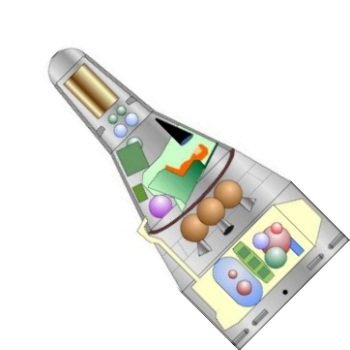Chinese Space Program 3 - History 3
The Cultural Revolution, which was started by Mao in 1966, convulsed China. During the Cultural Revolution, many bureaucrats, teachers, and other professionals were purged and forced to work in the countryside as Mao sought to removed "capitalist" elements from positions of authority. The turbulence that ensued did serious social and economic damage to China.
In 1969, the Shanghai’s 2nd Bureau of Mechanic-Electrical Industry started work on China's first heavy-lift satellite launch vehicle (SLV) called the FB-1. It was an all liquid propellant two stage rocket based on the design of the Chinese DF-5 intercontinental ballistic missile. At about the same time, the First Space Academy in Beijing started work on its own heavy lift vehicle known as the CZ-1, also based on the DF-5 ICBM design. The Chinese intermediate range ballistic (IRBM) DF-4 missile was used to develop a third state rocket motor to ride atop two liquid fuel stages for the Long March-1 SLV. The LM-1 SLV was used in an attempt to launch a Chinese satellite in November of 1969 but the launch failed.
In the spring of 1970, a satellite was successfully launched with a CZ-1 rocket. The Dong Fang Hong 1 (a.k.a. Mao 1) satellite weighed three hundred and eighty pounds making it the heaviest satellite launched by any country up to then. A one hundred and thirty square foot solar reflector was deployed by the solid fuel booster that inserted the satellite into orbit. The solar reflector made the satellite easy to see with the naked eye. A second satellite was successfully launched in the winter of 1971 with the last of the CZ-1 rockets. The ShiJian-1 satellite weighted about four hundred and ninety pounds.
A manned space program named Project 714 was initiated in the spring of 1971. Nineteen astronauts had been selected by March of 1971. The goal of the program was to launch two astronauts into orbit aboard the Shuguang manned spacecraft. The CZ-2A rocket was going to be used in the launch. The turbulence of the Cultural Revolution in China caused the program to be cancelled in 1972.
In the summer of 1972, a new heavy-lift rocket called the SLV FB-1 was launched but the test was only partially successful. The CZ-2A rocket was tested in November of 1974. It was used to launch a recoverable satellite called the FSW-0 but the launch failed. A modified CZ-2C rocket was used a few weeks later to successfully launch the FSW-0.
Mao died in the summer of 1976 and Deng Xiaoping emerged as the new leader of China in 1978. The nightmare of the Cultural Revolution ended with the ascent of Deng Xiaoping to power. Many of Mao's projects were slowed and some were just cancelled including military projects such as an anti-ballistic missile program and an ICBM radar tracking system.
Diagram of Shuguang manned spacecraft:
